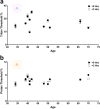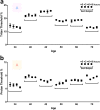Weeklong improved colour contrasts sensitivity after single 670 nm exposures associated with enhanced mitochondrial function
- PMID: 34819619
- PMCID: PMC8613193
- DOI: 10.1038/s41598-021-02311-1
Weeklong improved colour contrasts sensitivity after single 670 nm exposures associated with enhanced mitochondrial function
Abstract
Mitochondrial decline in ageing robs cells of ATP. However, animal studies show that long wavelength exposure (650-900 nm) over weeks partially restores ATP and improves function. The likely mechanism is via long wavelengths reducing nanoscopic interfacial water viscosity around ATP rota pumps, improving their efficiency. Recently, repeated 670 nm exposures have been used on the aged human retina, which has high-energy demands and significant mitochondrial and functional decline, to improve vision. We show here that single 3 min 670 nm exposures, at much lower energies than previously used, are sufficient to significantly improve for 1 week cone mediated colour contrast thresholds (detection) in ageing populations (37-70 years) to levels associated with younger subjects. But light needs to be delivered at specific times. In environments with artificial lighting humans are rarely dark-adapted, hence cone function becomes critical. This intervention, demonstrated to improve aged mitochondrial function can be applied to enhance colour vision in old age.
© 2021. The Author(s).
Conflict of interest statement
The authors declare no competing interests.
The authors declare no competing interests.
Figures





References
-
- Curcio CA, Millican CL, Allen KA, Kalina RE. Aging of the human photoreceptor mosaic: Evidence for selective vulnerability of rods in central retina. Investig. Ophthalmol. Vis. Sci. 1993;34:3278–3296. - PubMed
Publication types
MeSH terms
Substances
Grants and funding
LinkOut - more resources
Full Text Sources
Other Literature Sources
Medical

